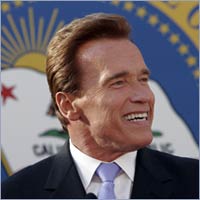SACRAMENTO /California Newswire/ — Governor Arnold Schwarzenegger today announced the first comprehensive list of 244 proposed renewable energy projects that could produce up to almost 70,000 megawatts (MW) of clean energy annually, building on California’s aggressive renewable energy goals. These proposed projects throughout the state include solar, wind, geothermal, biomass and small hydro facilities and will help move California towards achieving the Governor’s renewable energy goal of 33 percent by 2020. Currently California facilities produce just over 8,000 MW of renewable energy annually.
 “California is a pioneer in renewable energy, green jobs and environmental protection. Today’s announcement is proof we have a bright renewable energy future that will both fight climate change and drive our green economy,†said Governor Schwarzenegger. “This list of nearly 250 projects is great news for our state because not only will these projects help us meet our long-term environmental goals they will also create green jobs and new, clean investment in our economy now. My Administration will continue to work with our federal partners to expedite renewable energy projects to help meet our aggressive renewable energy goals while ensuring they comply with all state and federal environmental regulations.â€
“California is a pioneer in renewable energy, green jobs and environmental protection. Today’s announcement is proof we have a bright renewable energy future that will both fight climate change and drive our green economy,†said Governor Schwarzenegger. “This list of nearly 250 projects is great news for our state because not only will these projects help us meet our long-term environmental goals they will also create green jobs and new, clean investment in our economy now. My Administration will continue to work with our federal partners to expedite renewable energy projects to help meet our aggressive renewable energy goals while ensuring they comply with all state and federal environmental regulations.â€
In October, Governor Schwarzenegger signed a Memorandum of Understanding (MOU) with U.S. Department of the Interior Secretary Ken Salazar to expedite the permitting process for renewable energy projects in California and appointed a special advisor to oversee the fast-tracking of the permitting process for renewable energy facilities. California was the first state to sign an MOU with the Department of the Interior to cooperatively develop long-term renewable energy plans and to usher eligible projects through state and federal permitting processes that can receive 30 percent federal tax credits under the American Reinvestment and Recovery Act (Recovery Act).
Of the 244 proposed projects, up to 53 have indicated they will apply for Recovery Act funds and will break ground by the end of 2010. For those proposed projects looking for federal stimulus support, 22 could generate power at utility-sized levels of larger than 200 MW, totaling more than 9,000 MW. Many of the proposed projects are currently moving through a state, federal or local permitting process.
“I am very encouraged by the Governor’s renewable energy goals and his vision that development in California should occur on private and state lands, as well as on federal public lands,†said Secretary of the Interior Salazar. “Moving forward together on all these fronts will help ensure that we all can make responsible decisions on where to site these large projects while still protecting sensitive lands and resources in California.â€
Governor Schwarzenegger established California’s Renewable Portfolio Standard (RPS) by executive order calling for 33 percent renewable energy by 2020. The California Air Resources Board will adopt regulations to increase California’s RPS and provide clear and permanent direction for the creation, delivery and servicing of California’s renewable energy projects, which will help avoid another energy crisis while increasing the state’s renewable energy use.
In November 2008, the Governor signed Executive Order S-14-08 (EO) to streamline California’s renewable energy permitting process and increase the state’s renewable energy goals. Following this EO, the California Energy Commission (CEC) and the California Department of Fish and Game formed a cooperative relationship with the U.S. Bureau of Land Management and the U.S. Fish and Wildlife Service, called the Renewable Energy Action Team (REAT). This was a first-of-its-kind agreement to move California’s renewable energy development forward. The REAT agencies are working closely with the California Public Utilities Commission and the California Independent System Operator to further coordinate and streamline renewable energy development and permitting. The REAT is reviewing the proposed facilities that have submitted their applications to help meet the Recovery Act deadline. The CEC has also prioritized renewable projects that are not on federal lands and is moving quickly to review their applications.
In addition to the permitting work of the REAT, the agencies are working together on a long-term conservation strategy for the Colorado and Mojave Deserts. At the direction of the EO, the Desert Renewable Energy Conservation Plan (DRECP) was also formed to create a science-based, stakeholder driven process to identify geographic areas designated for renewable energy development, and conservation and declining species management. DRECP, in coordination with the Bureau of Land Management’s multi-state Solar Development Programmatic Environmental Impact Statement process, is using independent scientific review, stakeholder input, the best available biological data and an integrated planning process for the Mojave and Colorado Desert regions and parts of six Southern California counties. This plan is currently scheduled to be completed in 2012 and is meant to provide a long-term road map to development and conservation in the California desert.
A list of the 244 proposed projects that are currently in review or have been approved is available at www.energy.ca.gov/33by2020/documents/index.html . The projects are separated by those seeking Recovery Act funding. The project list is subject to change since some may lack financing, fail to meet strict environmental standards, or adequately address land use issues as part of the project approval process.
